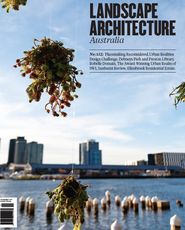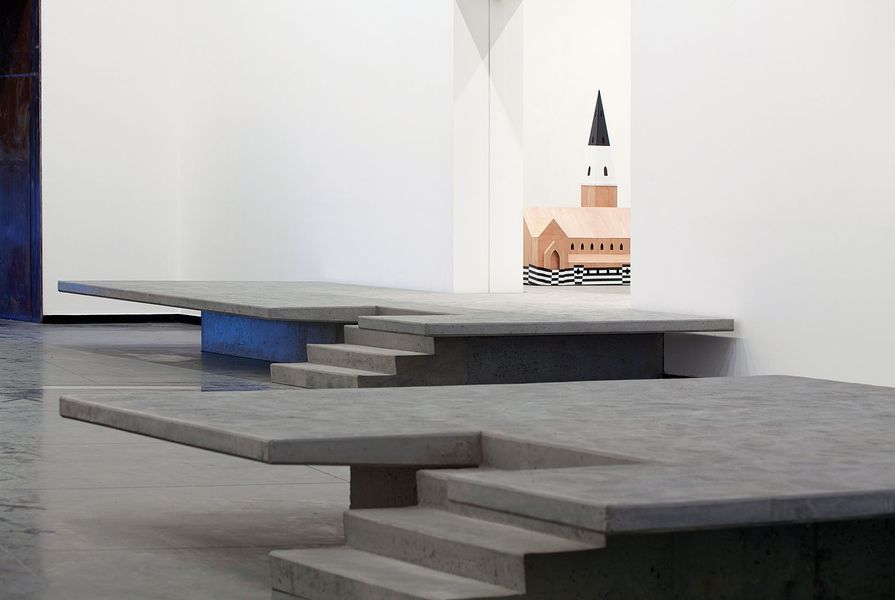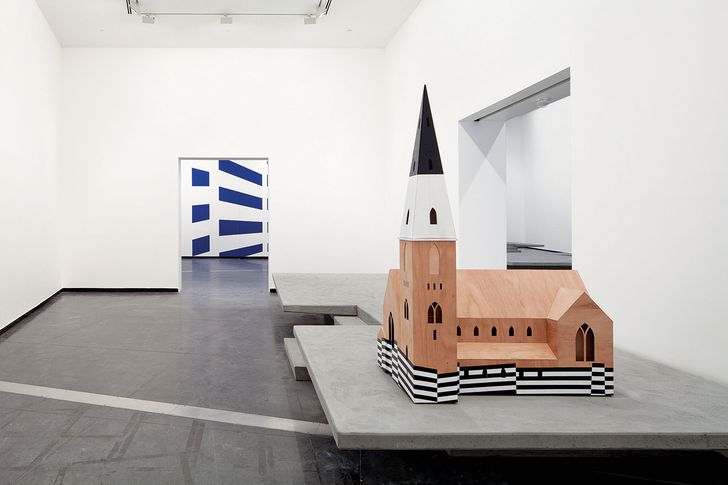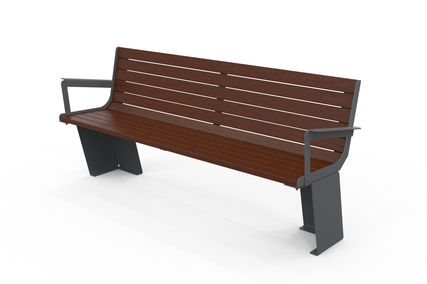The commission by Glaswegian Nathan Coley, Appearances, takes up the entire gallery space at the Australian Centre for Contemporary Art (ACCA), neatly compartmentalizing within the four gallery spaces four public places where individuals congregate to look and think and, as Coley expressed, “unfortunately” be seen. They are the public square, the gallery, the church and the school. Coley is concerned with people’s spatial relationships with these places, which result from the juxtaposition of a series of dichotomies: inside and outside, public and private, artificial and natural, real and imagined, seriousness and playfulness. It is largely in the ambiguity in which Coley’s inversions are made to appear that he wishes to provoke interpretations from his audience.
Appearances by Nathan Coley. Courtesy of Nathan Coley and Haunch of Venison, London.
Image: Andrew Curtis
In light of criticism regarding the lack of interior and exterior permeability of the Wood Marsh-designed ACCA building, Coley’s exhibition accentuates the division of space by an ironic inversion of place. In particular, Coley has transformed ACCA’s main gallery into a civic plaza suggestive of Oscar Niemeyer’s and Lucio Costa’s Brasília (1956–1960) after becoming intrigued by a low, flat platform in the Praça dos Três Poderes (Plaza of the Three Powers) in front of the Supremo Tribunal Federal (Supreme Federal Court) building. In the plaza at Brasília, a socle supports the narrow overhanging platform, emulating the effect created by the cantilevered columns of Niemeyer’s building that raise its mass so it appears to hover above the concrete expanse of the ground plane. Coley has copied the platform, pouring three reinforced concrete examples within the gallery, to the bemusement of his concrete contractors who normally would expect the permanence of the material to be utilized for longer than just the exhibition’s duration. Behind one platform, a block of wall mirrors is used to suggest the presence of a skyscraper facade looking down on the plaza, affording both the surreptitious surveillance of the individual and the self-reflection of their own egotistical and voyeuristic gazes.
Coley’s exhibition is also imbued, perhaps inadvertently, with a reference to another iconic functionalist design of the twentieth-century pioneering the formal possibilities of reinforced concrete. Situated in the main gallery next to the middle platform, a “tree,” its trunk and branches festooned with multicoloured light bulbs, is reminiscent of Robert Mallet-Stevens’ collaboration with Jean and Joël Martel at the 1925 Exposition des Arts Décoratifs et Industriels Modernes in Paris, where four concrete arbres cubiste (cubist trees) were constructed in a garden. Inspired by his visit to Luna Park, Coley’s tree continues the quirky questioning of the commonly perceived distinction between the artificial and the natural that Mallet-Stevens and the Martels began with their concrete cruciform trunks and quadrangular jutting branch planes. The tree provides light relief from the dour uninhabited platforms and hints instead at an occupied, fun-filled potential use of the space.
The third platform serves as a bridge for entering the second gallery, where a hardboard model loosely based on Melbourne’s Scots’ Church is perched inside on its corner. The model is subsumed in a space where the only other visual cue lies on the wall opposite, an illuminated sign reading “Never Trust a Loving God.” The model, with its optically deceptive razzle-dazzle camouflage, continues Coley’s interest in both waning and conflicting religious authority previously explored in Camouflage Church (2006) and Camouflage Bayrakli Mosque (2007). In the adjoining gallery the walls are plastered with a dazzle mural based on Saint Andrew’s Cross, whose same distorted abstractions were originally designed to confuse rather than conceal the speed and direction of Allied ships from enemy eyes during World War I. More than the other public places, the gallery and the church overlap as spaces for contemplation and as iconic repositories. Three framed prints of the wall mural are hung on the mural itself, further reinforcing the two spaces’ shared attributes, while simultaneously interposing a sense of dislocation through the difference in scale and use of perspective.
In the last gallery, the film Another Lecture, narrated by Cate Blanchett, is shown. Stills of derelict sites in Glasgow and Melbourne depict back alleys and vacant lots where rubbish and weeds are described as deliberate design interventions, mocking the seriousness of the usual design rationale. Whether Coley needs to contribute to a different understanding of these derelict spaces beyond the smirk of enjoyment arising out of this playful artistic intervention is for each viewer to determine. Similarly, did the fact that it was an Oscar-winning actor impersonating academic architectural diatribe enhance the ruse? As art critic Sebastian Smee observed recently, many contemporary artists continue to work within “the safety of irony,” the joke a little tired now a century after Duchamp’s urinal.
With his admixture of mediums – planar images, video and illuminated and interactive sculptures – that isolate the everyday, Coley’s corpus sits remarkably close to the work of Canadian-born Australian Callum Morton, their artistic trajectories overlapping this year with concurrent exhibitions in Melbourne. Morton, who initially trained as an architect, also has a recurring interest in exploring the spatial characteristics influencing people’s relationships with built environments, especially within a modernist aesthetic. Coley’s model of the skeletal, multi-storey IRA-bombed Marks & Spencer building in Manchester, I Don’t Have Another Land (2002), with the letters of the piece’s title emblazoned across some of the blown-out windows, refers to public loss as experienced through changes to a built environment. This is evoked in much the same way in Morton’s Gas and Fuel (2002), a model of the building destroyed to make place for Melbourne’s Federation Square, replete with its aurally looped message of “Help me. Please help me!” Furthering their shared artistic concerns are exhibitions of the same name, International Style, held within a year of each other a decade ago and pieces like Morton’s Babylonia (2005), an artificial rocked Hadean walkthrough that equates to Coley’s walk-on platforms in Appearances, encouraging individual self-experience within the public sphere through eliciting a range of sensory perceptions.
The ambiguity exploited by Coley may embolden some to poke about the cultural and socio-religious tensions that determine the ownership of place. In a forum associated with the exhibition, SueAnne Ware saw some non-Indigenous Australian’s attitudes to Uluru profoundly reflected by Coley’s Trespass and Loiter sign. However, for many Australians, suggesting alternative views of place has no more of an effect on them than a holiday or carnival, temporarily providing amusing relief from the serious beliefs that centre the everyday structure of their own lives. After all, there’s nothing wrong with appearing to have a bit of fun along the way.
Nathan Coley’s Appearances was on display at the Australian Centre for Contemporary Art in Melbourne from 28 May to 24 July 2011.
Source

Discussion
Published online: 21 Feb 2012
Words:
Julian Bull
Images:
Andrew Curtis
Issue
Landscape Architecture Australia, November 2011


















